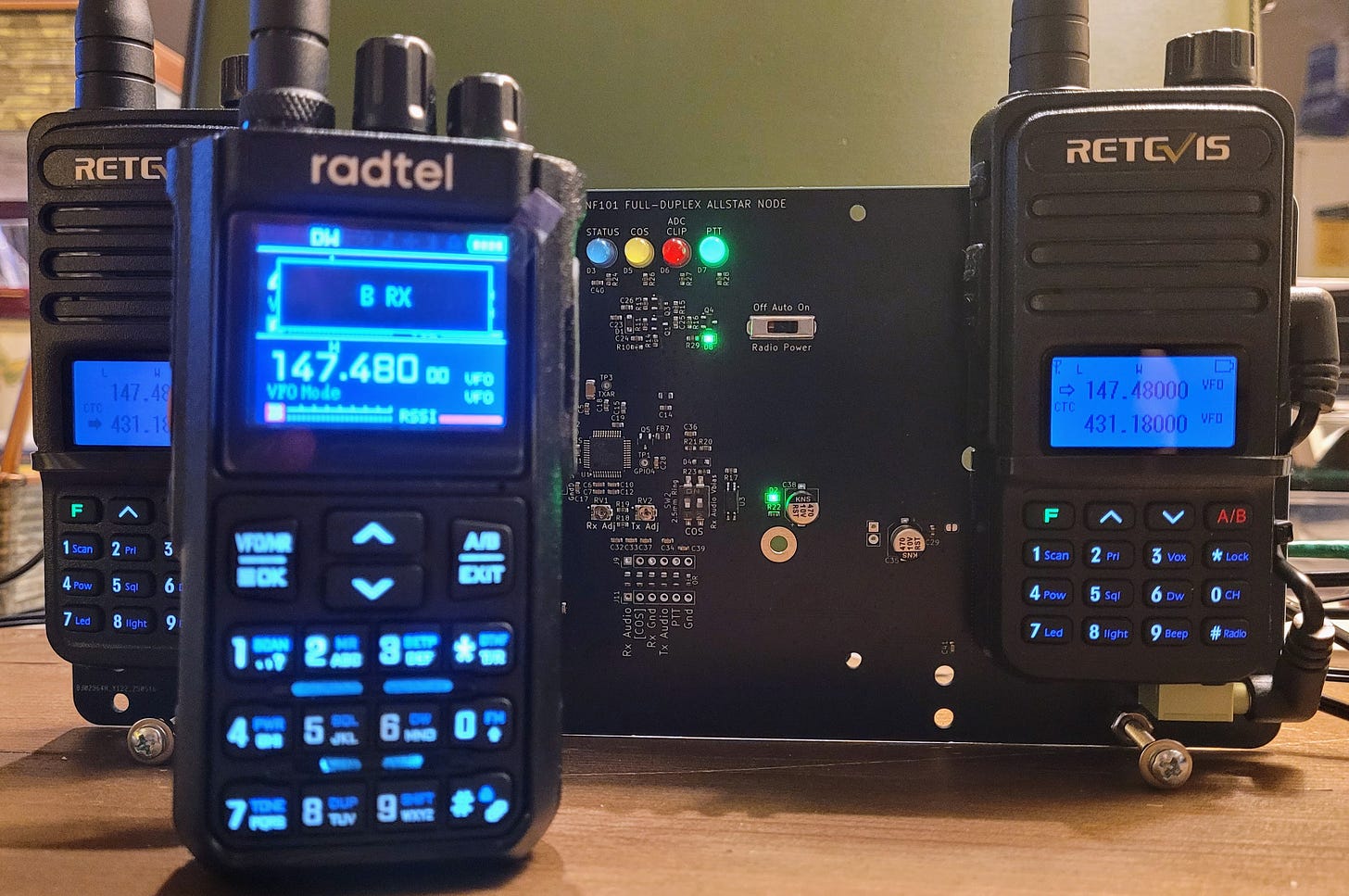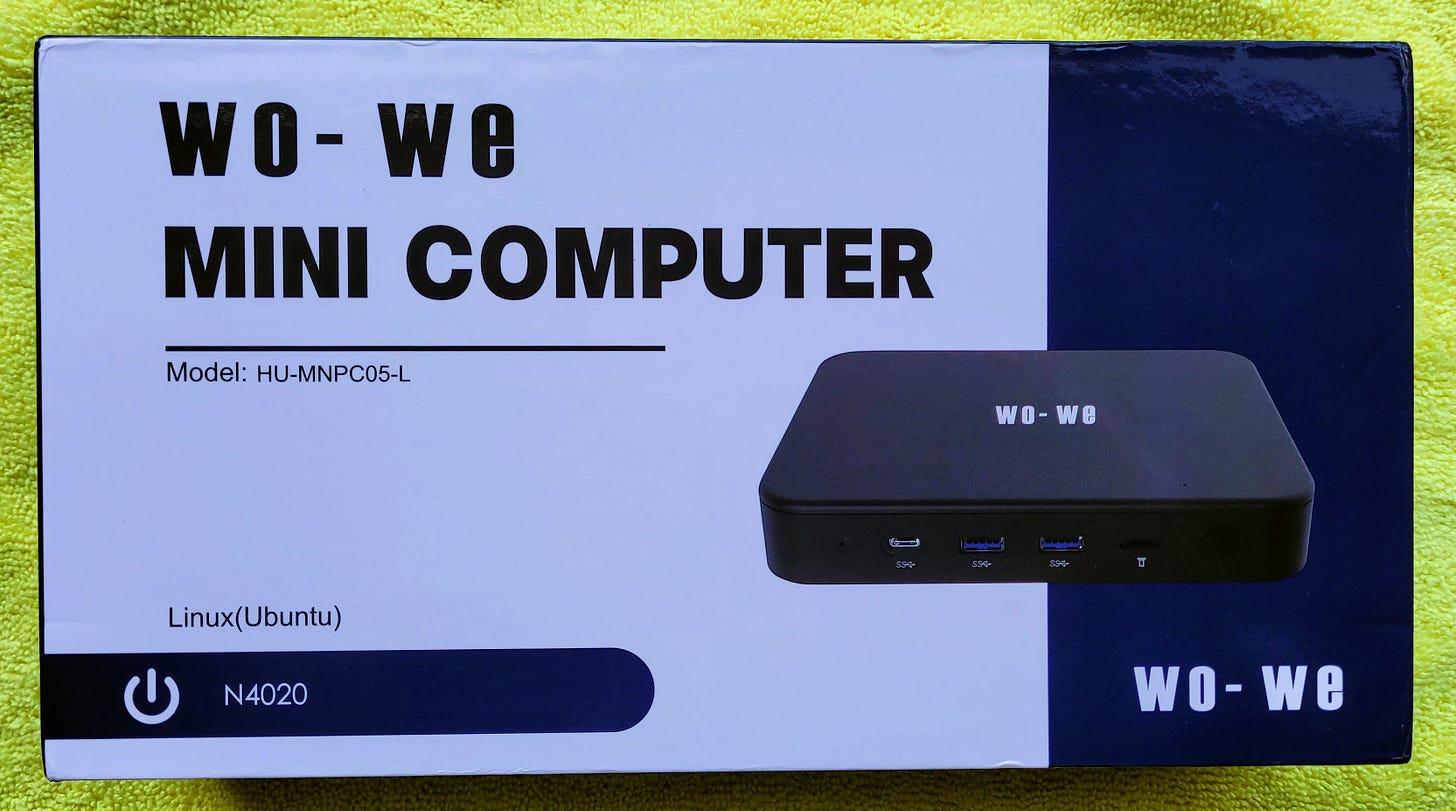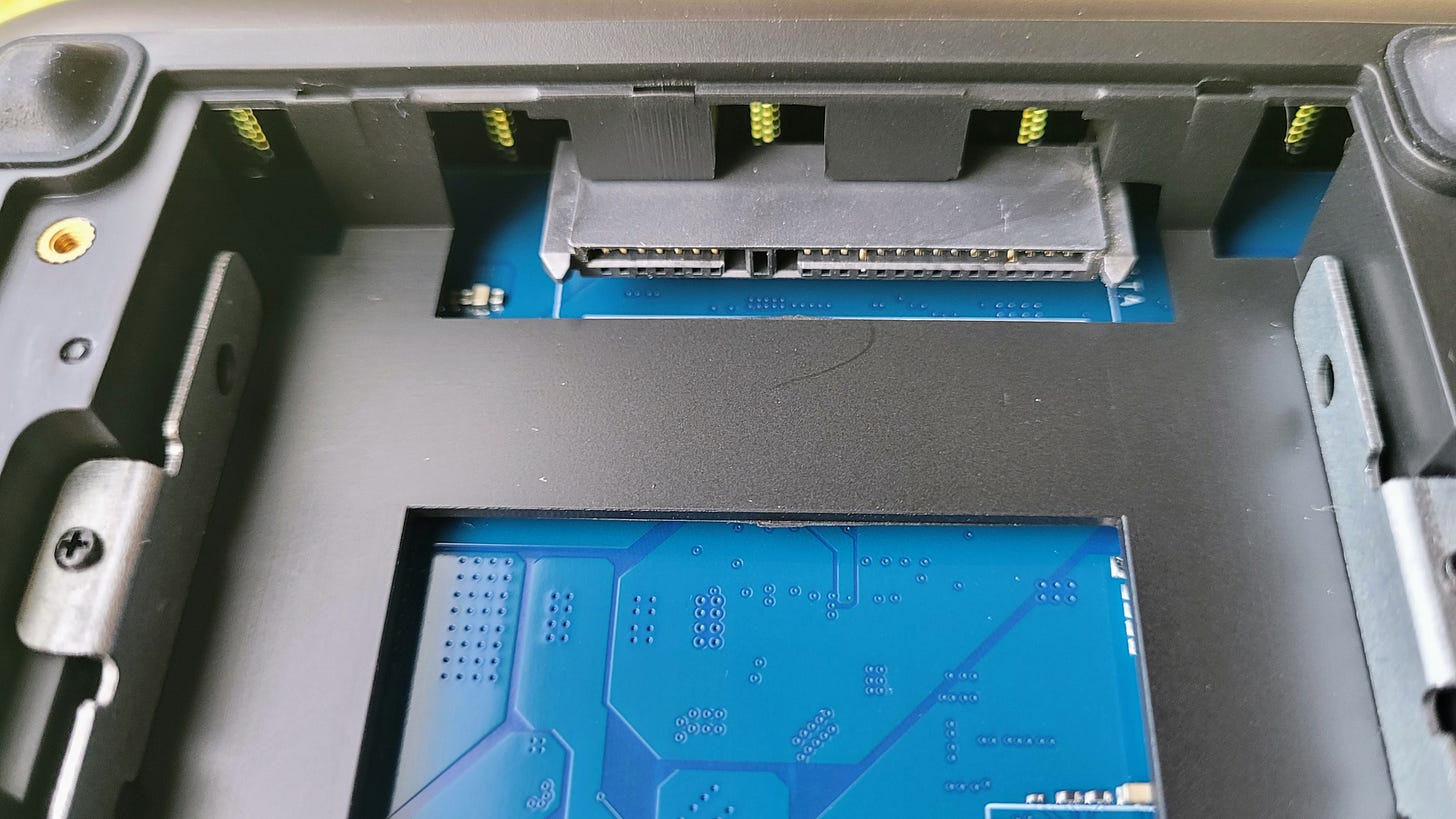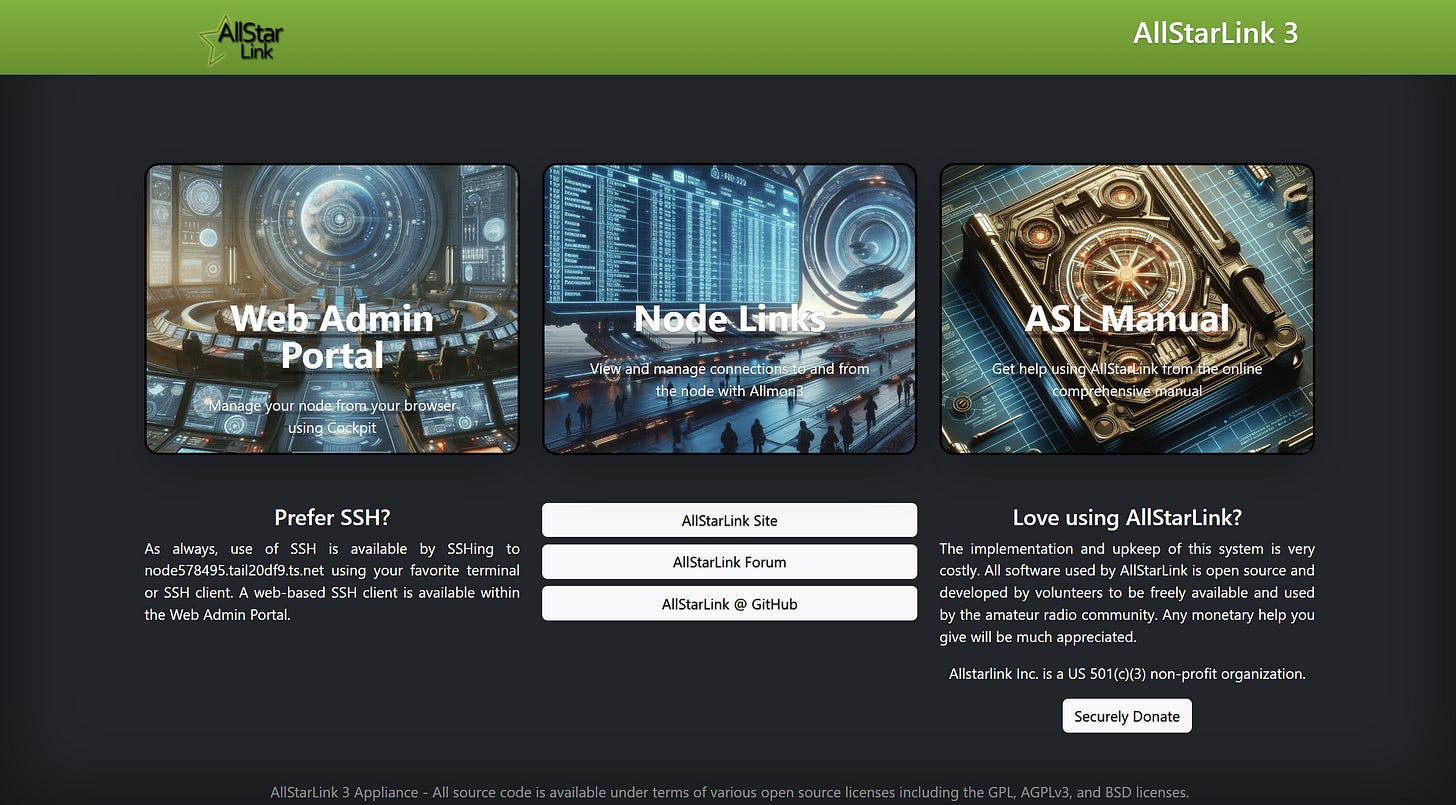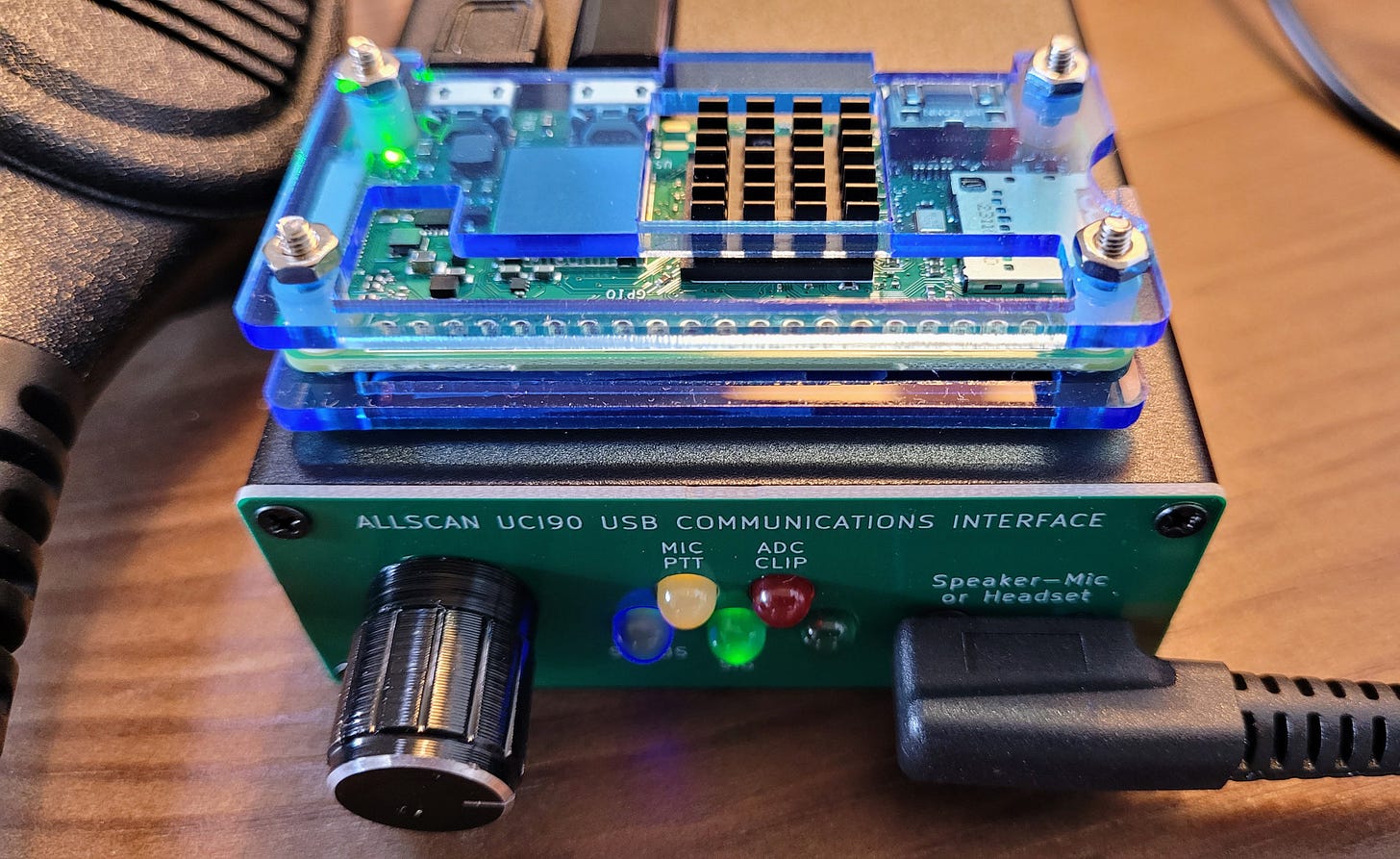As I type this, it is a lovely Thursday morning: warm, with blue skies and a light breeze. However, I thought I had already started issue 135, so it was an unpleasant surprise to open my browser and find a blank screen where issue 135 ought to be. This means issue 135 is going to be a bit briefer than usual, a bit less well crafted, and perhaps a day late. EDIT: Yes, it is a day late!
New full-duplex AllStar node
The highlight of this past week for me was receiving and setting up a new AllStar node. I purchased the ANF-101 full-duplex node from David Gleason NR9V (doing business as AllScan.info). The published description is:
ANF101-M-RT85 Full-Duplex Node Radio Module — 100% USB-powered with no separate adapters, chargers or batteries required. Plugs into any MiniPC or RPi 3/4/5 with a single USB cable. 1 / 2 / 2.5 Watt Tx power
If you visit his “Radio Modules” link at https://allscan.info/products/#modules, you’ll see three devices: the URI141-RT85, the URI150-RT-85, and the ANF101-M-RT85. I now have all three of these.
The ANF101 is the newest. I set it up with a Dell Wyse 3040 micro PC. To do that, I started with a fresh download of Debian 12, then followed the ASL3 instruction guidelines on GitHub. Then I installed Allmon3 and AllScan.
Unlike the URI141 and URI150 devices where the RT-85 radio sends and receives in half-duplex, the ANF101 is a full-duplex unit, with one RT-85 dedicated to receiving and the other dedicated to transmitting.
In the image below, you see the receive radio is set to 431.18000 MHz and the transmit radio is set to 147.48000 MHz. My Radtel handheld is receiving the transmission from the ANF101 on 147.48000 MHz.
I really, really like this device. While it is a bit bigger than the URI141 and URI150 devices, it has a cool steampunk-esque feel to it. It’s a blend of cutting-edge amateur radio crafting with exposed circuitry. The audio quality sounds every bit as good to me as with the half-duplex units I already have.
What I don’t have is a good full-duplex handheld. I’ve read online that my Icom ID-5100A mobile radio can do full duplex so I’ll dive into that when I next make a trip to Portland to retrieve it. I just made an offer on a pretty dirty Icom IC-W32A handheld so maybe I’ll get lucky and get a working duplex HT. Replacement batteries are still widely available.
In the meantime, how am I operating a full-duplex node without a full-duplex handheld radio? By using two handheld radios! One is set to receive, as in the image above. My TIDRADIO TD-H8 handheld is set to the transmit frequency, so I have my receiving HT sitting a few feet away and turned down to just be able to hear it. This lets me detect if I’m doubling with someone and then I can stop transmitting until the channel is clear.
Radios while I’m in “away” status
I’ve got a couple of handheld radios on order. More on those when they arrive.
While I’m spending almost every day, all day, working from my wife’s skilled nursing facility room (aka a SNF or “sniff”), I’m not “radio poor.” With me, I have:
-
Two Radtel handheld radios
-
A few Retevis RT-85 handhelds
-
A Yaesu FT-5DR handheld and my home-built hotspot that I use for Yaesu System Fusion and M17
-
A Connect Systems CS7000 handheld radio for M17 through the hotspot
-
A Yaesu FTM-300DR mounted in the pickup truck
That sounds like a lot, but it really doesn’t feel like enough. Essentially, I left my DMR radios at home, and brought analog and digital VHF/UHF radios with me.
On my laptop, I have EchoLink and DroidStar. Unfortunately, both applications are blocked by the SNF’s firewall appliance when I try to use the facility wifi.
On my Android phone, I have DVSwitch Mobile. My IAX and Web Transceiver connections are blocked by the firewall. My Hamshack Hotline number (programmed into Groundwire) is blocked.
But when I use a cellular connection instead of wifi, DroidStar and DVSwitch Mobile work. EchoLink works. My Hamshack Hotline number works (it is connected to my AllStar node 57945).
I share these details to illustrate some of the problems people in restricted settings may have. It’s harder to be an active radio amateur in an institutional environment, but it’s not impossible. That’s the takeaway here.
I also have a couple of handheld radios on order, plus an extended battery kit from W0AEZ to give my Yaesu FT5D a much longer operating time.
When I made a quick day trip to Portland, I grabbed my Kenwood TH-D74A so I could brush up on how to operate it.
I also snagged a couple of old Ten-Tec Scout radios in the hope that one of them will work okay in the vehicle. I don’t plan to operate mobile, as in while driving. Instead, I’ll try to operate portable from the cab of the pickup truck.
The antenna I plan to use has mixed reviews:
For this, I have a mag mount:
During my very quick trip, I did not find my box of band modules for the Ten-Tec Scout transceivers, so what I have are the modules installed in these radios: 80 meters and 40 meters. I’m not going to try 80 meters with the GRA-750B antenna, but I will try transmitting on 40 meters. (And I’ll try to remember where I stashed my 10-12-15-17-20 meter modules!)
Cheap computer arriving soon arrived
I purchased a very inexpensive mini PC that should arrive soon arrived yesterday. I want to see if it has enough power to run AllStar. Here’s the link:
I note that “Celeron” is misspelled and that the item is out of stock. My fingers are crossed that this (and similar inexpensive devices) have enough “juice” run AllStar. I spent my available time working on the new ANF101 AllStar node so I have not yet booted up this device, but that will happen very soon.
I did take a moment to look at the ports. It has a USB-C port and a microSD port, unusual for such an inexpensive machine.
I also popped the bottom off and found a mass storage drive connector:
Do you know what fits in that connector? The user manual is very light on details. I know I’ve seen it before, and even used it before, but I’m forgetting what device(s) work with it.
Radtel radio shipped
This radio is coming from China. It is available directly from Radtel but also through Amazon:
I also ordered a tri-band antenna because this HT also does 220 Mhz.
Radtel Tri-Band Flex Antenna RHD-771S 144/220/430Mhz 35cm/13.7inch SMA Female Foldable Soft Antenna Compatible with Baofeng/Kenwood/Radtel RT-490 RT-470X RT-890 RT-495 RT-630 RT-900 RT-860 RT-4D Radios × 1
Package tracking says the order has been shipped but I see no status updates yet. I’m guessing the radio will arrive in the next week or so.
Raspberry Pi-based AllStar node
While waiting for radios to arrive, I assembled a Raspberry Pi Zero 2W in a simple case, then installed AllStar on it (see the next item below for a photo). This was a slightly different experience for me since most of my ASL nodes are built with mini PCs running Debian Linux. The RPi node is ASL node 578495, with AllScan and Tailscale added to the build. (I installed Tailscale this morning, before I left for the SNF.)
I bought a Raspberry Pi Zero 2W kit because it came with a power supply and some extra bits, but I didn’t need the extras.
-
$39.99: CanaKit Raspberry Pi Zero 2 W Basic Kit with Official Case
-
$8.89: Raspberry Pi Zero Case Kit with Heatsink, HDMI Adapter, for Pi Zero 2 / W
The USB hub allows for a wired Ethernet connection and places to plug in my wired keyboard and wired mouse. During installation, I used a small mini-monitor for the screen.
My Tailscale admin console provides various ways to connect to other addresses in my Tailnet. Usually, I use the Tailscale IP address for a particular device, but today I used the Tailscale domain name to connect to the RPi node. In this case, it was http://node578495.tail20df9.ts.net/
From there, I can jump to Allmon3 or AllScan, or just view the Cockpit interface. This is the Cockpit screen running on the RPi Zero 2W:
Small K-1 speaker-mic adapter
I got a chance to test a prototype of an AllScan UCI90 speaker-microphone adapter. This adapts a standard K-1 microphone adapter to interface with (in my case) a tiny AllStar node built with a Raspberry Pi Zero 2W.
The RPi is stuck to the top of the interface box with some tape. What you are looking at is a radio-less AllStar node, complete. The whole thing weighs almost nothing and fits in the palm of your hand.
I was testing version 0.95 of the UCI90 board. Version 1 is arriving now and I think this is going to be a big hit with folks. Many of us already have a K-1 speaker-mic in our trove of radio gear. The ability to use an inexpensive, simple microphone helps to make AllStar even more accessible to radio amateurs.
More on internet-connected systems
More about my piece titled The importance of internet-connected systems for amateur radio community and connections. That piece generated more personal emails to me than any other thing I’ve written in the past two years.
A few days after I published it, Ham Radio Workbench Podcast 238 was posted. Near the very end of that podcast, George KJ6VU spoke about the many conversations he had with people who raised some of the things I had written about. Hearing that, my observations were validated.
Internet-connected radio systems are exceptionally valuable to some members of our amateur radio community. While such systems aren’t everyone’s cup of tea, they meet a real need and help connect radio friends who we wouldn’t otherwise hear from.
I’m thinking hard about this. Expect an announcement in a few weeks! (Yes, that is the very essence of a teaser!)
73 to all. Touch a radio every day!

